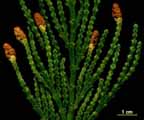
Shoot of an ornamental specimen (Seattle, WA) showing foliage and slightly immature pollen cones [C.J. Earle]. |
Calocedrus decurrens
(Torrey) Florin 1956
Common NamesIncense-cedar; white, bastard, or California post cedar (4), cedro incienso [Spanish] (6).Taxonomic notesSyn: Libocedrus decurrens Torrey 1853 (6).DescriptionResinous, aromatic tree 18-46(57) m tall and 90-150(360) cm dbh. Tapering, irregularly angled trunk and narrow, columnar crown, becoming open and irregular. Bark light or reddish-brown, thick, fibrous, deeply and irregularly furrowed into shreddy ridges. Twigs much-branched and flattish, with wedge-shaped joints longer than broad; composed of scalelike leaves. Leaves evergreen, shiny, opposite in 4 rows, 3-14 mm long, scalelike, including long-decurrent base, rounded abaxially, apex acute (often abruptly), usually mucronate, the side pair keeled, long-pointed, overlapping the next pair, extending down twig; aromatic when crushed. Pollen cones red-brown to light brown. Seed cones cones red-brown to golden brown, 14-25 mm long (including wings), oblong-ovate when closed, pendant at end of slender, leafy stalk, proximal scales often reflexed at cone maturity, median scales then widely spreading to recurved, distal scales erect. Seeds 4 or fewer in cone, paired with 2 unequal wings. 2 n = 22 (2, 6).RangeUSA: W Oregon, Nevada (the Lake Tahoe area) and California; Mexico: Northern Baja California Norte; at 300-2800 m in mountains. Occurs in mixed conifer forests or (seldom) pure stands (2, 6). See also (8).Big TreeDiameter 378 cm, height 50.3 m, located in Marble Mountains Wilderness, CA; also diameter 183 cm, height 69.8 m, located in Umpqua National Forest, OR (5).OldestThere is a record of 933 years, but without supporting information (7).DendrochronologyEthnobotanyThe tree is widely grown as a handsome ornamental. Formerly it was also an important timber species, much preferred for the manufacture of pencil due to its softness and isotropy. Although timber harvests have been reduced by depletion of old growth stands, its wood, exceptionally resistant to decay and highly durable when exposed to weather, is still useful for woodworking applications including cedar chests and closets (2, 6).ObservationsHave seen in many locales, including the Sierra San Pedro Martir, Mt. San Jacinto, many parts of the Sierra Nevada, and the South Cascades as far north as H.J. Andrews Experimental Forest. One of the more remarkable areas is Cedar Basin in Red Butte Wilderness, California, where it grows in an almost pure stand and some quite large trees are found.RemarksTolerant of moderate intensity fire because of its thick bark (2).Citations(1) Silba 1986 .(2) Little 1980 (as Libocedrus d. ). (3) Burns & Honkala 1990 (as Libocedrus d. ). (4) Peattie 1950 (as Libocedrus d. ). (5) E-mail communication from Robert Van Pelt, who measured these trees; 18-Mar-1998. (6) John W. Thieret at the Flora of North America web page . (7) Carder 1995 . (8) Robert S. Thompson, Katherine H. Anderson and Patrick J. Bartlein. 1999. Atlas of Relations Between Climatic Parameters and Distributions of Important Trees and Shrubs in North America. U.S. Geological Survey Professional Paper 1650 A&B. URL= http://greenwood.cr.usgs.gov/pub/ppapers/p1650-a/pages/conifers.html , accessed 22-Jan-2000 (as Libocedrus decurrens ). See also Arno & Gyer 1973 and Lanner 1983 . |
|
back | Calocedrus | Cupressaceae | home
This page is from the Gymnosperm Database
|